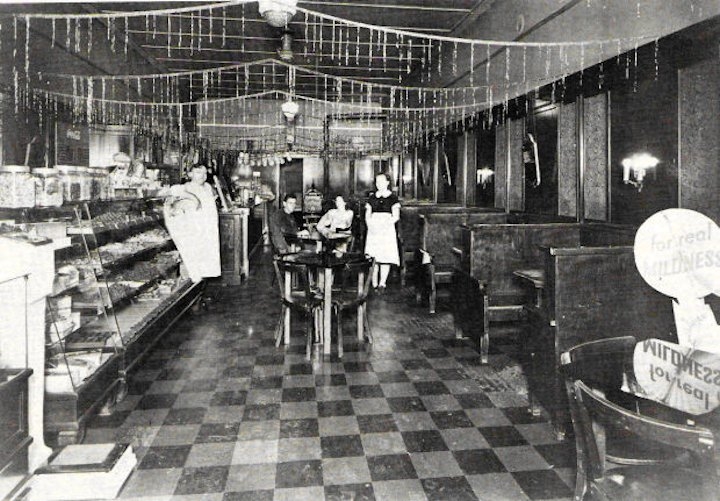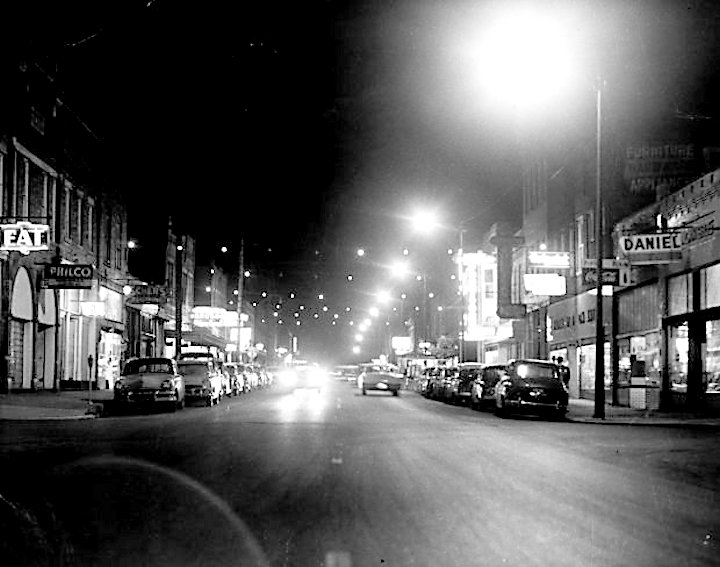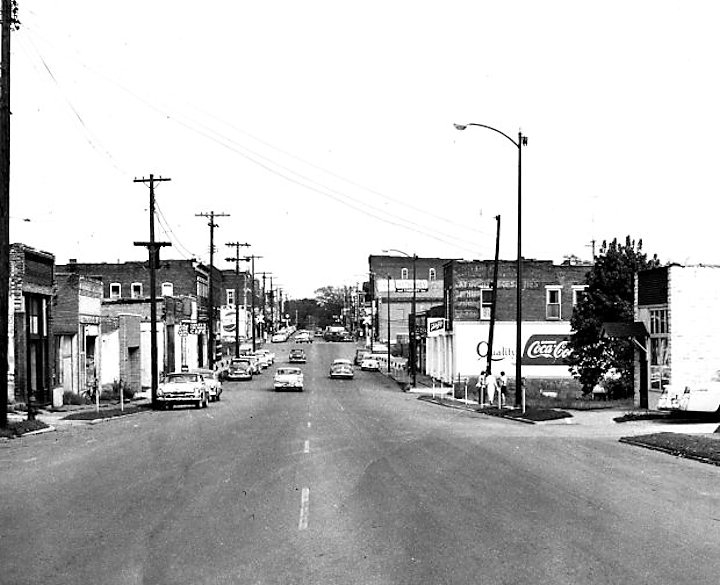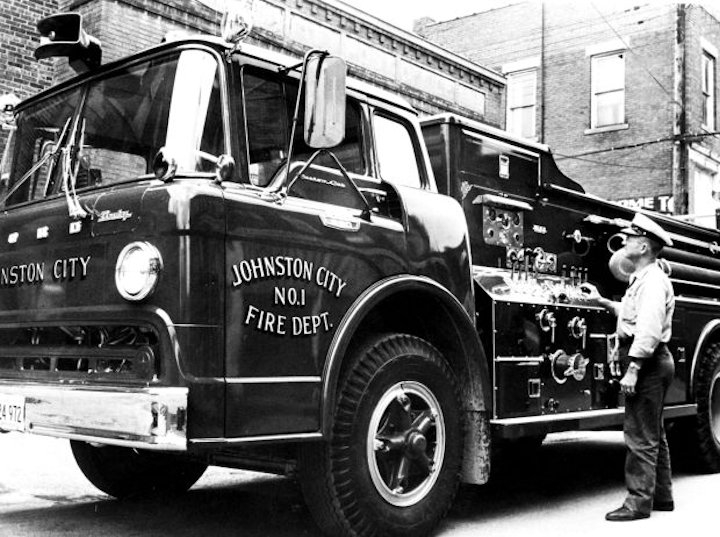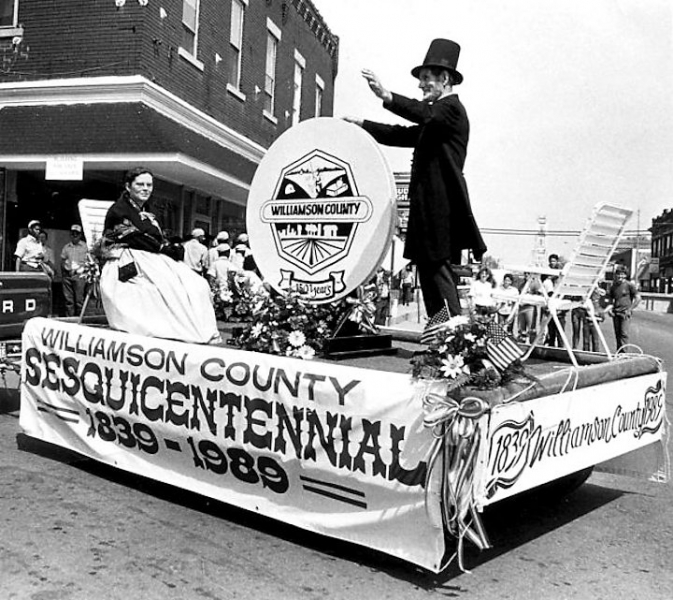Johnston City owes its creation, name, and location to the coming of the railroad in 1894. The Chicago, Paducah, and Memphis built its route from Altamont to Marion along the line between Herrin and Lake Creek townships. The contracting firm was Johnston brothers and Faught; the first two partners lived in St. Elmo; the third, in Alton. The railroad named their station in honor of Ben F. and P. M. Johnston, whose firm was one of the largest and best known engaged in railroad construction at that time.
A village plat was surveyed August 27, 1894 and filed the next week with Circuit Clerk William T. Davis. The original survey for Johnston City was in section 19 of Lake Creek Township.
A. C. Stiritz had engaged the interest of his former Alton associates in building the railroad, and as soon as the location of station and right of way was assured, he opened a general store with John Kopp as his partner. Stiritz and Kopp was the first business house in Johnston City and R. J. Stiritz in 1939 was still in business at the same location his father purchased in 1894. Mr. Stiritz became the town’s first undertaker, led a bank and building and loan organization, and dealt extensively in real estate. The mining village of Stiritz was named for him.
Residents of nearby Jeffersonville were quick to see the opportunities offered by the new town and moved their stores and houses a mile westward. The community rapidly outgrew the original plat and extended north into section 18 of Lake Creek Township and west into the adjoining sections of Herrin township. The post office of Lake Creek, was moved into Johnston City and a village incorporated under the latter name February 11, 1896. The post office name became officially Johnston City on December 30, 1903.
Benjamin Ralls Felts (1842-1914) was one of those who moved in from Jeffersonville as the beloved doctor of the community. His four acre home place was a landmark of Johnston City until his death. Doctor Felts was a son of William Hargis Felts (1814-1875), a soldier in the Seminole war and a deacon in Hartwell Baptist church.
The family came to Williamson County in 1850, and the son soon left as a soldier to defend the Union. He was wounded and taken prisoner, and assigned to hospital service after his parole. His interest in medicine aroused, he became a student of Dr. Edward L. Denison in Marion, graduated from medical college in St. Louis, and returned to Williamson County to practice. He was justice of the peace and county commissioner, and during the last years of his life the oldest practicing doctor in the county. His son, Dr. Harvey A. Felts of Marion, carried on the family profession
A railroad from the west was built into Johnston City in 1895 and operated by the Illinois Central after October 1, 1897 although it was not conveyed to that company until December 15, 1902. This line was first known as the Chicago and Carbondale, later as the Chicago and Texas. Its western terminus was originally Carbondale.
The Chicago and Eastern Illinois railroad bought the north and south route in 1899 and extended it to Thebes.
The first newspaper and the newspaper in 1939, was the Johnston City Progress, edited by Richard W. Jones. Though many other papers have been established in the town, sometimes two or three in one year, none has broken the even tenor of the Progress and its weekly editions under Mr. Jones’ direction. From 1898 to 1901 Mr. Jones had as his partner James H. Felts who also served in the legislature.
James W. Turner established the Independent, whose first issue was dated March 10, 1905. He was editor two years and received the support of many of his former students at Crab Orchard academy.
W.O. Potter came to the new town in 1898 as head of the schools, and stayed to become city clerk, attorney, and mayor. After he moved to Marion he was elected state senator and an account of his life may be found in the section devoted to members of the general assembly.
D.H. Henson came in 1896 to mine and opened his grocery in 1902. His son, Attorney Ray D. Henson, commenced practice in 1918 on the second floor of the Henson building. Mr. and Mrs. I. Friedman came from St. Louis in 1904 to open their first small clothing store. Among the other early business men were Charles Cazaleen, who came in 1899; W.C. Ferges who moved his general store from Herrin to Johnston City in 1912; Ben L. Baiar, who moved in from his farm in 1915 to sell buggies, harness, and farm implements. John W. and Ira E. Jones bought the Potter drug store in 1917. Snider S. Vick left Carterville to open another of his family’s drug chain at Johnston City in 1918.
The banks of the city were organized in rapid succession. The Johnston City State Bank started in 1904 with Peter Wastier, A.C. Stiritz, and W.S. Hardesty as officers. The Citizens’ State Bank opened its doors in 1907, with W. H. Grant, Harry Barlow, and L. D. Hobbs in charge. Richard G. Fleming became president of the First national bank in 1909.
All this time the life of Johnston City was its coal. P.H. (“Pat”) Holland struck coal at his shaft early in May 1902. With his partner, James Duggan, Mr. Holland developed the greater part of the Johnston City field. Old Ben Coal Corporation came into the picture about 1920 and bought their mine 17 in section 24, mine 18 in section 12 of Herrin Township. After fifteen years’ operation, water from underground lakes flooded abandoned workings first in the south, and then worked along the deeper levels to the north. Bulkheads, dams of soy beans and of bentonite clay, frantic pumping was resorted to. The water was irresistible. Mine after mine closed, the last Franco mine at Stiritz. The shipping mines of Johnston City were suspended.
Johnston City, incorporated February 24, 1905 as a city and home of 5,955 people by the 1930 census, saw its livelihood drown.
See also, Jeffersonville History
Note: Pieces of the old Johnston City State Bank are housed and on exhibit at the Williamson County Historical Society museum at 105 S. Van Buren St.
(Extracted from Pioneer Folks and Places by Barbara Barr Hubbs)

